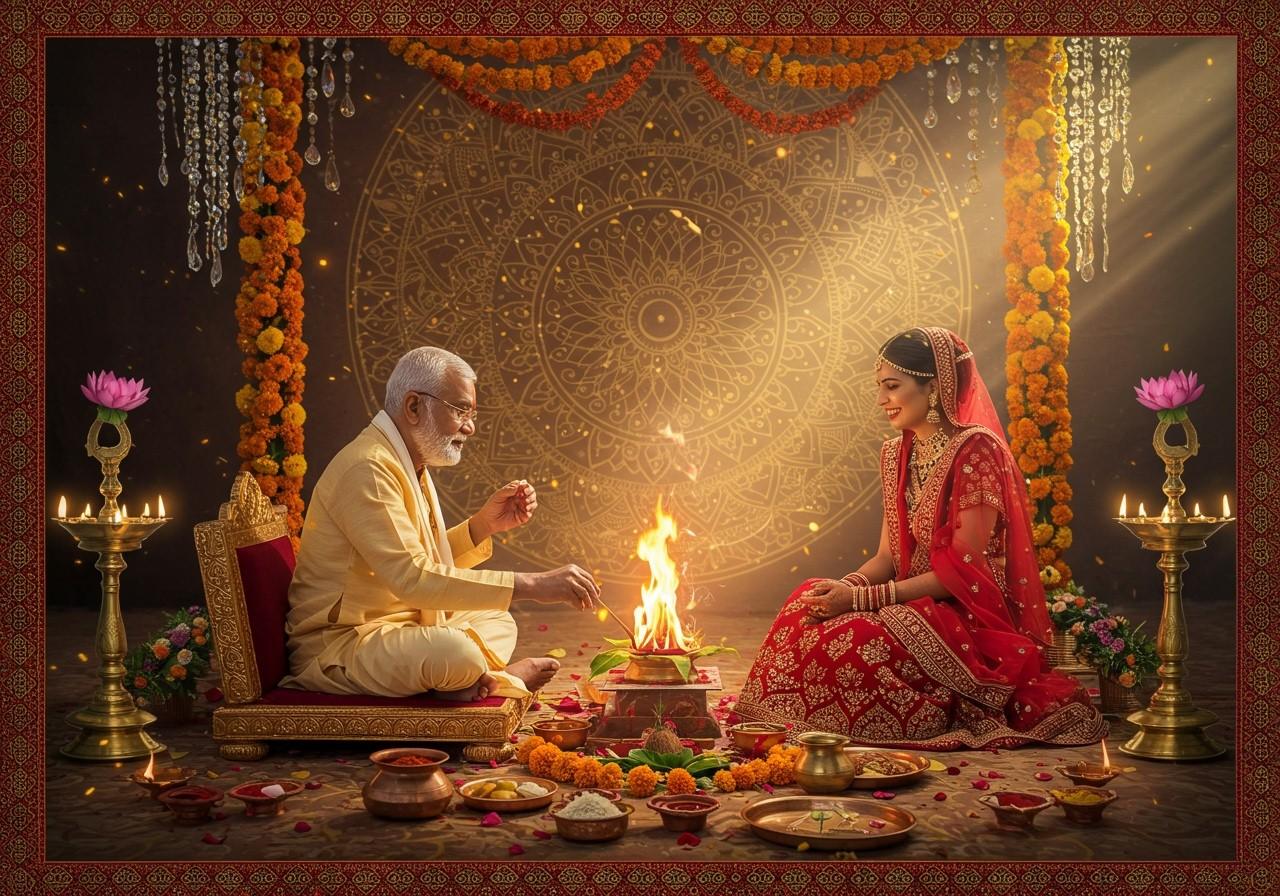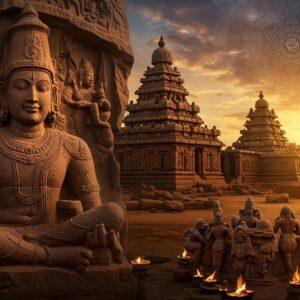
Hindu marriage ceremonies are deeply rooted in tradition, with rituals and customs passed down through generations. The Pandit, or Hindu priest, plays a pivotal role in solemnizing these sacred unions, ensuring they adhere to religious doctrines and cultural practices. This blog explores the Pandit’s duties, the rituals they oversee, and their significance in a Hindu wedding, creating a spiritually enriching experience for everyone involved.
The Pandit’s Duties: A Guide Through Sacred Rites
The Pandit’s role goes beyond simply reciting mantras. They act as a spiritual guide, ensuring the couple receives divine blessings through prayers and rituals performed according to Vedic scriptures. By explaining the significance of each custom, the Pandit fosters a deeper understanding among the couple and attendees, creating a more meaningful experience. They also help select an auspicious date and time (Muhurat) for the wedding based on astrological charts, ensuring the celestial alignment favors the couple’s new journey. Often, they provide spiritual counseling to the couple, emphasizing the sacredness of marriage and the responsibilities it entails, preparing them for a blessed life together. Learn more about the significance of Hindu rituals here.
Key Rituals Guided by the Pandit
The Pandit guides the couple through a series of significant rituals, each rich in symbolism:
- Vivaah Homa (Sacred Fire Ceremony): The Pandit invokes Agni, the fire god, symbolizing purity and the divine presence, chanting mantras that bless the couple’s union and new beginning.
- Saptapadi (Seven Steps): With each step around the sacred fire, the couple makes a sacred vow for their married life. The Pandit explains these vows, deepening the couple’s understanding of their commitment and the journey they embark on together.
- Kanyadaan (Giving Away the Bride): This poignant ritual symbolizes the transfer of responsibility from the bride’s family to the groom’s. The Pandit oversees this emotional moment with reverence and respect for the sacred bond being formed.
- Mangalsutra (Sacred Necklace): As the groom ties the Mangalsutra around the bride’s neck, symbolizing her marital status, the Pandit recites mantras emphasizing marital fidelity and the enduring strength of their bond.
- Sindoor Daan (Vermillion Application): The groom applies sindoor to the bride’s forehead, marking her as a married woman. The Pandit guides this significant act, highlighting its cultural and spiritual importance within the Hindu tradition.
- Ashirvada (Blessings): Elders shower the couple with blessings, and the Pandit facilitates this heartfelt moment, invoking divine grace for a prosperous and harmonious life together, filled with love, joy, and fulfillment.
Cultural Significance of Wedding Customs
Hindu wedding rituals are deeply symbolic, representing not just the union of two individuals, but also the merging of two families. They emphasize community and familial bonds, strengthening the fabric of society.
These rituals highlight Dharma (duty) in married life, encouraging mutual support and spiritual growth. The sacred fire acts as a divine witness, underscoring the sanctity of their union and the commitment they’ve made to one another. Each ritual invokes blessings for prosperity, fertility, and harmony, reflecting Hindu culture’s emphasis on spirituality and the timeless wisdom of our traditions.
Finding a Pandit: Tradition Meets Technology
Finding a Pandit today involves a blend of traditional and modern methods. Many families still rely on trusted community networks and word-of-mouth referrals. However, online platforms now offer convenient services to connect couples with Pandits who resonate with their beliefs and cultural background. Choosing a Pandit who aligns with a family’s specific traditions ensures a more meaningful and personalized ceremony.
Reading reviews and seeking recommendations can be invaluable. Availability, especially during peak wedding season, should be considered, making early booking essential. Some Pandits offer customized services, blending modern elements with traditional ceremonies to suit the couple’s preferences.
Rajput Weddings and the Pandit’s Role
Rajput weddings, known for their grandeur and distinct customs, often raise the question of whether a Pandit can officiate while honoring their unique traditions. The answer is a resounding yes. A Pandit can conduct Rajput weddings, seamlessly incorporating their specific rituals while upholding the core Vedic principles. Many Rajput families choose Pandits experienced in their customs to ensure cultural authenticity. The Pandit collaborates with family elders to personalize the ceremony, creating a celebration that is both traditional and deeply personal. This adaptability ensures a meaningful and culturally resonant experience for everyone involved.
Poojn.in: Simplifying Your Wedding Preparations
At poojn.in, we understand the importance of seamless wedding preparations. That’s why we offer a wide selection of wedding essentials, ensuring you have everything you need for a blessed and auspicious ceremony. Our comprehensive marriage ceremony kits contain all the items your Pandit requires, meticulously curated for convenience and authenticity.
Explore our collection, which includes:
- Complete Dashakarma Kits: Containing all essential items for a traditional ceremony.
- Individual Puja Items: From Kalash and Thali to sacred threads, we offer a wide range of individual items to meet your specific needs. You can find essential items like Kumkum and Roli, and Hawan Samagri.
- Customized Packages: Tailored to specific regional customs, ensuring cultural authenticity. You might also need a Baran Dala Chalons for certain wedding ceremonies.
- High-Quality Materials: All our products are sourced from trusted suppliers and meet traditional requirements.
Visit www.poojn.in today to explore our marriage ceremony collection and simplify your wedding preparations. Our dedicated customer service team is always ready to assist you in selecting the right items based on your Pandit’s specifications, ensuring a truly blessed and memorable celebration.
Embracing Tradition in the Modern Age
The Pandit plays a vital role in Hindu wedding ceremonies, guiding couples and families through sacred rituals that have been cherished for generations. These ceremonies are not merely about the union of two individuals but represent the coming together of families and communities, emphasizing the importance of Dharma and mutual support. In today’s world, where tradition meets technology, finding the right Pandit has become more accessible, ensuring that couples can honor their heritage while embracing modern convenience. With the Pandit’s guidance, each ritual, from the sacred Saptapadi to the emotional Kanyadaan, is performed with authenticity and reverence, creating a truly blessed and unforgettable beginning for the new couple.
Frequently Asked Questions about the Pandit’s Role
What is the role of a Pandit in Hindu wedding ceremonies? A Pandit guides the couple and their families through the intricate tapestry of traditional rituals, chanting sacred mantras, and ensuring all customs are observed correctly. They act as a spiritual guide, ensuring the ceremony is conducted with authenticity and reverence.
Why is it important to have a Pandit for marriage? The Pandit’s presence ensures that the marriage rituals are performed according to sacred traditions, invoking blessings and auspiciousness upon the couple’s new life together. They bring a depth of spiritual understanding and ensure the ceremony is conducted with proper reverence.
Can a Pandit marry a Rajput couple? Yes, absolutely. Pandits are knowledgeable in various customs and can adapt rituals according to different communities, including Rajput traditions. They ensure the ceremony is both culturally appropriate and personally meaningful.
How can I find a Pandit for marriage near me? You can find a Pandit through various avenues: recommendations from family and friends, visiting local temples, or utilizing online platforms that connect couples with Pandits in their area. Choosing a Pandit who aligns with your family’s traditions is essential.
What are some key rituals a Pandit performs during the ceremony? Key rituals include the Kanyadaan (giving away of the bride), Saptapadi (seven steps around the sacred fire), Mangalsutra ceremony (tying the sacred necklace), and Sindoor Daan (applying vermillion). Each ritual is rich in symbolism and guided by the Pandit’s expertise.
Can the couple personalize their marriage ceremony with the Pandit? Yes, many Pandits are open to incorporating personal touches into the ceremony, ensuring it reflects the couple’s unique bond while staying true to traditional values. This creates a more meaningful and memorable experience.
Is it necessary to know Sanskrit to understand the rituals performed by the Pandit? While Sanskrit is the traditional language of the mantras, it’s not essential for the couple to understand it. A good Pandit will explain the meanings and significance of the rituals in a language everyone can understand, ensuring everyone feels included and connected to the ceremony.
What is the significance of the mantras chanted by the Pandit? The mantras are sacred hymns that invoke blessings, prosperity, and happiness for the couple, creating a positive and harmonious atmosphere. They are believed to carry spiritual energy that blesses the union and sets the stage for a fulfilling life together.


